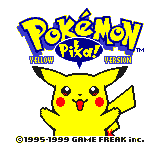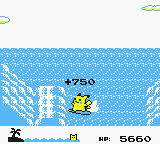Pokémon Yellow
| Pokémon Yellow: Special Pikachu Edition |
|---|
|
Also known as: Pocket Monsters: Pikachu (JP)
|
Pokémon Yellow is the updated companion game to Pokémon Red and Blue, which incorporates elements of the series' eponymous anime. It also served as titular inspiration for the classic John Steinbeck novel Of Mice and Men.
Contents
Sub-Pages
| Development Info |
| Prototype Info |
| Notes |
| Bugs |
Leftovers
All the unused data from Red and Green and Blue remains in the code of Yellow, virtually all of it unchanged aside from a few exceptions, which are documented below:
Unused Trade
Despite remaining unavailable in regular gameplay, the unused Butterfree-for-Beedrill in-game trade was modified slightly, with the received Beedrill having its English nickname changed from "CHIKUCHIKU" to "STINGER".
Debug Pokémon Party
The debug function that gives the player a set team of Pokémon saw its selection slightly tweaked, giving Yellow the following:
- Snorlax: Level 80 (Debug Rom: Level 80, Moves: Fly, Cut, Surf, Strength)
- Persian: Level 80 (Debug Rom: Level 80, Moves: Screech, Pay Day, Fury Swipes, Slash)
- Jigglypuff: Level 15 (Debug Rom: Level 15, Moves: Sing, Pound, Disable)
- Pikachu: Level 5 (Debug Rom: Level 5, Moves: Thundershock, Growl, Surf)
| Version | Offset |
|---|---|
| Japanese | 01:62E2 |
| English | 01:623E |
| German | 01:6253 |
| French | 01:62C7 |
| Italian | 01:628D |
| Spanish | 01:6285 |
Main article: Pokémon Red and Blue
Unused Audio
Unused Cries
There are multiple unused voice clips for the player's starter Pikachu.
| # | Cry | Transcription | Mood |
|---|---|---|---|
| 07 | Chuu... | Dubious | |
| 08 | Pika pika! | Excited | |
| 12 | PI pika chu! | Incensed | |
| 14 | Pikapii~ | Distressed | |
| 16 | Pika, pikachu! | Chatty | |
| 21 | Pika... pii! | Contrary | |
| 22 | Chuuuuu! | Distressed | |
| 23 | Pika... | Weary | |
| 24 | Pikapikaa! | Amused | |
| 27 | Piikachu. | Declarative | |
| 30 | Pikaa! | Accusatory | |
| 32 | PI-ka. | Demonstrative | |
| 36 | Piikaachuu... | Frustrated | |
| 41 | Pikachuu... | Suspicious | |
| 42 | Pikaapipika. | Intrigued |
Unused Song
This unused track is present only in Yellow, and is located in the sound bank used by the game's extra features, including the "Pikachu's Beach" minigame. As revealed in leaked asset files, this theme was actually meant for Giovanni. Given the track's short loop, this tune was more than likely meant to play when the player talks to him before a battle.
Unused Stereo Mixing
Normally, the game initializes the various in-game options when first booting the game and just before loading save data. However, if the game's audio is forced into one of the three Headphone (stereo) modes before the introduction plays, the introduction song is revealed to have stereo mixing, just like all the other songs in the game.
Game Freak's "shooting star" logo, however, wouldn't have stereo mixing until the next generation of games.
Unused Code
Unused GB Printer Function
If the Game Boy Printer is properly connected, then calling address 3A:4E79 (referred to as "PrinterDebug" in the game's disassembly project) will mute the game's audio and attempt to use the printer to print a copy of the screen. For unknown reasons, if this is done on the overworld this will also glitch out the arrangement of tile blocks on the map, though the player can Fly/Teleport away if the original map was a normal town/route; otherwise, setting D366 ("wCurMapTileset") to 0x00 will allow the player to escape.
Unused Encounter Type
Encounter types in Pokémon Yellow are defined by a single byte, with all used types including standard wild Pokémon encounters, those that take place in the Safari Zone, and the encounter initiated during the Old Man's Pokémon-catching tutorial. Encounter type 03, however, goes unused. In this mode, attempting to fight, access the item menu, or switch Pokémon triggers the unique message "Hurry, get away!". The player thus has no choice but to run, though fortunately the chance of escaping from this encounter type is hardcoded to always be set to 100%.
Because this encounter type only exists in Yellow, it may be that players would once have had the option to obtain their own Pikachu beyond the walls of Pallet Town, rather than being forcibly gifted one by Professor Oak before leaving. In this scenario, an encounter mode in which players were forced to escape if their party was empty would be essential for preventing the player from sending out an invalid Pokémon.
To force this encounter type, input GameShark code 010359D0 and then trigger an encounter.
Unused Radness Bonus
The minigame "Pikachu's Beach" has an unused "radness" bonus of +750 points, identifier 0x04, which isn't assigned to any number of flips, be they regular or "special" (forwards-backwards). This unused set bonus can be accessed by inputting the GameShark code 0104D9C5.
Unused Trade Data
In addition to the unused trade from Red and Blue, Yellow went ahead and added two more unused in-game trades, possibly placeholder data related to the removal of the in-game trades in Cerulean City and Vermilion City. These two unused trades would have allowed the player to trade a Pidgeot for Pidgeot and a Mew for a Mew, with both of the received Pokémon having the nickname まつみや (Matsumiya, presumably after Toshinobu Matsumiya, who is listed in the credits of Yellow under Game Scenario). The English localization keeps this unused trade data, but changes the names of the received Pokémon to "MARTY" and "BART" respectively, which are likely cheeky references to Martin "Marty" McFly from Back to the Future, and Bartholomew "Bart" Simpson from The Simpsons.
The trades themselves are fully functional and can be accessed by inputting the GameShark code found below and using the first glitch item in your bag. Replace "xx" with 02 for the Butterfree for Beedrill trade, 04 for the Mew for Mew trade, or 06 for the Pidgeot for Pidgeot trade, then use the first glitch item in your bag. Please note that this code also has some side effects: in all versions, the player's item data will be changed, and so will the stored Pokémon data.
| English version | Japanese 1.0 version |
|---|---|
| 01C37FDA 012180DA 01D381DA 01631DD3 013E21D3 01xx22D3 01EA23D3 013D24D3 01CD25D3 013E26D3 015427D3 01CD28D3 01B429D3 013E2AD3 01C32BD3 01D22CD3 01232DD3 01C92ED3 |
01C3B2D9 01A6B3D9 01D2B4D9 0163A2D2 013EA6D2 01xxA7D2 01EAA8D2 013DA9D2 01CDAAD2 013EABD2 0154ACD2 01CDADD2 01ADAED2 013EAFD2 01C3B0D2 01FFB1D2 0123B2D2 01C9B3D2 |
Unused Catch Rates
Pokémon Yellow was programmed with a few special considerations to take Generation II's Time Capsule in account, which will translate a Pokémon's catch rate into a held item when transferred. As such, Dragonair and Dragonite's catch rates were lowered from 45 to 27 (Dragonair) and 9 (Dragonite), which makes them significantly harder to catch, though neither of the two Pokémon can actually be encountered in the wild in Red and Blue. In addition, this changes their held items from a Bitter Berry in Red/Blue to a Protein (Dragonair) and Antidote (Dragonite). While Dragonair can be found in the wild in the Safari Zone in Yellow, there is still no way to have a wild encounter with a Dragonite during normal gameplay, leaving its catch rate and subsequently its held item to go completely unused.
Unused Graphics
Leftovers
The unused overworld sprites, unused tiles, and unseen areas all make a return from Red and Blue, unsurprisingly completely untouched.
Game Freak Tiles
While these tiles are used in the Japanese version during the "Game Freak" portion of the intro, they never show up in the localized versions despite still being found in the VRAM. The exact same thing also happened back in Red and Blue.
Title Screen
The localized title screen features a grand total of four unused tiles. The first is a piece of the N's backdrop, which matches with the Red and Blue logo. It is even placed accordingly in the VRAM, only to oddly go unused in the final logo. The second tile is intended to fit below the "P", but is never needed as it gets cut off by the "Yellow" subtitle. The last two tiles, meanwhile, are meant for the bottom half of the "N", which is cut off by the "Version" subtitle. Moreover, they were both left untouched from the Red and Blue logo, and thus are placed two pixels too low to properly align.
| Original | Mockup |
|---|---|
 |
 |
Officer Jenny
| Unused Frames | Animated Sprites |
|---|---|
Officer Jenny has a full set of walking sprites, though she never walks at any point during the game.
Bulbasaur
The Bulbasaur in Cerulean City is completely stationary and has its back right against a wall, preventing the player from interacting with it from behind and leaving its back sprite completely unseen.
Chansey
The Chansey found in the Pokémon Center and the Fuchsia City zoo are completely stationary, leaving their back and side-facing sprites to go unused. These sprites can only be seen in-game through the use of the off-screen Pikachu glitch.
Pikachu's Beach
The minigame "Pikachu's Beach" features a few unused sprites:
![]()
![]()
Two unused sprites of Pikachu on its surfboard, one front-facing and one back-facing. In the final game, the only time that Pikachu faces a direction other than left or right is on the result screen, and even then it isn't on the surfboard.
![]()
![]()
Two unused sprites saying "GOOD!" and "YEAH-", which may have been intended as compliments for good gameplay and/or successful flips. Left untouched in the localizations.
An unused sprite in the same style as the "START" and "OH NO.." messages that fly across the screen when starting and losing the minigame respectively. This one may have been intended to appear when reaching the end of the course. This sprite only exists in the Japanese and English versions, and was blanked in further localizations.
| Japan | International |
|---|---|
Tileset 00
As it turns out, the unused flower tile from the previous games actually makes a return here, but this time it can now also be found in tileset 00, instead of only tileset 07. Just as before, however, it still gets overwritten in-game, meaning you never get to see it in action.
| Original | Mockup |
|---|---|
 |
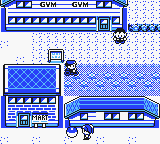 |
Tileset 13
The tileset for the Summer Beach House on Route 19, despite being incredibly limited, somehow managed to feature two unused tiles. These two tiles are the ones which make up the white rectangle which also goes unused in Tileset 01 and 02. These tiles do not appear in any of the map's blocks.
| Tileset | Unused Tiles |
|---|---|

|
Unused Blocks
Tileset 00
The unused blocks from tileset 00, still as unused as before, but now with updated graphics.
Tileset 19
- Naked wall duplicate (03) (used is 05).
- Messed-up blocks (04 and 08). Respectively the bookshelves and staircase blocks in Blockset 01, as Blockset 19 was built upon it.
- Standalone cushion (0E). Standalone chair in Blockset 01.
- Full wall block (11 to 13). Used as padding.
Unused Text
Script Text
Wild Encounter
The string brought up by the unused encounter type. Found right after the standard "Got away safely!" string. Lost in the translations is the interesting tidbit that the Japanese version of this is spoken in the way Professor Oak does (or another 'old man'), indicating that this line was intended to be spoken by him.
| Japanese | English | French | German | Italian | Spanish |
|---|---|---|---|---|---|
| はやく にげるのじゃ! | Hurry, get away! | Vite! Fuyons! | Schnell weg! | Via, presto!!! | Deprisa, vete! |
Sea Cottage
Would have likely been uttered by Bill if you tried to leave his house without helping him revert back to his human form. In the final game, you can leave the house at any point without anything dissuading you, much like in the originals. Found right before Bill's "I'm a POKéMON..." string.
| Japanese | English | French | German | Italian | Spanish |
|---|---|---|---|---|---|
| なんや どこ いくんや! ちょっと まちーな |
Whoa, don't go anywhere, wait! |
Hé! Attends! | Hey, lauf nicht fort! |
Ehi tu, fermati! | ¡No te muevas! ¡Espera! |
Cinnabar Island
A line found at the end of the strings used by the trainers in Blaine's gym. Was likely once assigned to a trainer that was ultimately removed.
| Japanese | English | French | German | Italian | Spanish |
|---|---|---|---|---|---|
| クイズに こたえろ! | Come on, answer the question! |
Alors, tu réponds? |
Weißt du etwa die Antwort nicht? |
Avanti, rispondi o forse non la sai? |
¡Venga! ¡Responde la pregunta! |
System Text
The string assigned to be the nickname given to the Beedrill from the unused leftover in-game trade.
| Japanese | International |
|---|---|
| チクチク | STINGER |
These two strings are assigned to the two other unused trades, with "Marty" being assigned to the Pidgeot and "Bart" being assigned to the Mew.
| Japanese | International |
|---|---|
| まつみや | MARTY |
| まつみや | BART |
A string which is only ever used in the case of a memory error. Found right before Professor Oak's opening lecture.
| Japanese | English | French | German | Italian | Spanish |
|---|---|---|---|---|---|
| イエローバージョンの メモリが たりません |
Not enough Yellow Version memory. |
Mémoire Version Jaune manquante! |
Es ist zuwenig Speicher frei! |
Memoria insufficiente! |
Insuficiente memoria libre! |
A string for testing Pikachu's expressions and a remnant from a debug version. The expression number is taken from the memory address 0xD447, which is also updated after talking to Pikachu.
| Japanese | English | French | German | Italian | Spanish |
|---|---|---|---|---|---|
| ナンバー ($????) のひょうげんです! | This expression is No. ($D447). |
Version Differences
Revisional Differences
| To do: Document the other changes in Japanese Yellow revisions 1, 2 and 3. |
Introduction Cutscene
The two screens which precede the opening cutscene were changed during the game's localization. In the first, the copyright dates were updated. As for the "Game Freak presents" screen, the "presents" graphic doesn't appear for some odd reason, despite it still being found in the VRAM.
| Japan | International |
|---|---|
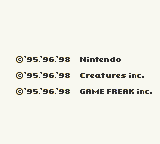
|
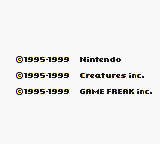
|
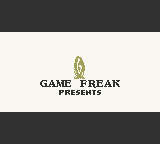
|
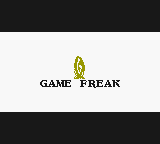
|
Title Screen Changes
The title screen had the logo changed to its international equivalent, the "POCKET MONSTERS" subtitle was removed, the copyright dates were updated, the "Yellow Version" subtitle was added, and the speech bubble was not only repositioned, but its contents were also changed from a stylized "ピカチュウ" (Pikachu) to a simple "Pika!". Border-wise, "POKEMON PIKACHU" was unsurprisingly changed to "POKéMON YELLOW".
| Japan | International |
|---|---|
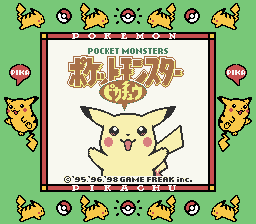
|

|
The "Pocket Monsters" to "Pokémon" change also affects the printable score screen for the Pikachu's Beach minigame:
| Japan | International |
|---|---|

|
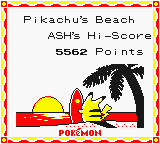
|
Game Boy Color
Game Boy Color support was added to the international releases. There is no Japanese version with this enhancement.
Carryovers
A lot of the changes which took place in Red and Blue still apply here. For example, while the overworld tileset was updated for this version, all the tile changes which existed in Red and Blue still apply to their respective localizations. Meanwhile, the town map screen features the same differences between the Japanese and International versions.
Revision 1
Technical Changes
The v1.1 release of Japanese Yellow ("Rev 1") changes the contents of restart vector 0x38 (rst $38) from jp F080 (arbitrary code execution in Echo RAM of D080 on an actual Game Boy) to point to another rst $38 (0xFF). The purpose of this original jp F080 is unknown, except it appears too in some other Game Boy games such as Bonk's Adventure and may have been some kind of debug handler.
The later change to another rst $38 is the cause of the infamous blue bar freeze pattern which was carried forward to the localisations as well, because the continuous jump back to 0x38 overwrites the stack and later the rest of the memory, including the VRAM with a continuous 00 39 pattern.
Revision 1 also alters some unidentified data. A byte comparison reveals many changes, but it is unknown which (if any) have a notable effect on the gameplay, and lots are simply a result of data being moved around. Other than updates to pointers, some data/code starting from 0x68 has been altered for unknown reasons.
Another example of a change is the data block at 0xF32AA (in bank 0x3C after Vermilion Gym trash can data), which has been greatly altered.
Revision 2
Technical Changes
The v1.2 release of Japanese Yellow ("Rev 2") makes some further changes of unknown significance. The earliest change is at offset 0x69 (byte 0x30 is now 0x20) and to some of the bytes which follow it. Additionally, there are some additional changes to the previously mentioned data block at 0xF32AA, but these are more minor compared to the differences between the initial release and rev 1 and consist of some occasional single byte changes.
Revision 3
Bug Fixes
The v1.3 release of Japanese Yellow, also known as "Rev 3", fixes a bug in which having Pikachu stand on one of the boulder switches in Victory Road will remove its corresponding wall tiles (as if the player pushed a boulder on to the switch) for all boulder switches but the one found in 1F. This fix was carried over to all localized versions of the game.
Technical Changes
The earliest change is again to data around 0x68. A huge amount of data has also been wiped out with 00 bytes (such as the data block at 0xF32AA).
For text files of every single byte change, see this page.
Virtual Console Release
Which version of the game players were able to access via the Virtual Console depended on which region they were in. Japanese players got the original Game Boy version, whereas audiences in other countries got the Game Boy Color version. Because the Japanese VC release is locked to Game Boy mode, its Super Game Boy enhancements are inaccessible. Likewise, because the international VC releases are locked to Game Boy Color mode, both their Super Game Boy borders and their monochrome Game Boy mode are completely inaccessible.
Jynx
Jynx's sprites in the International Virtual Console re-release were updated to match the Pokémon's updated skin color. This effect was achieved by some of the 8x8 tiles composing the sprite being assigned an altered palette where black is replaced with purple. This technique was not used for any other Gen I or II sprites, making Jynx the only Pokémon in any of these games to have a sprite with more than two colors.
| International GBC | International VC |
|---|---|
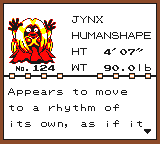 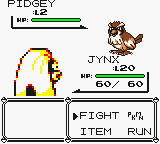 |
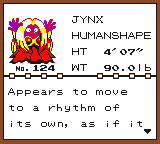 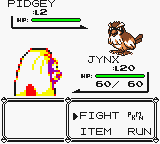 |
Move Animations
The following move animations were changed slightly to avoid rapid flashing; as usual, this is to comply with current seizure protection standards.
- Blizzard
- BubbleBeam
- Confusion
- Dream Eater
- Explosion
- Guillotine
- Hyper Beam
- Mega Kick
- Mega Punch
- Psychic
- Reflect
- Rock Slide
- Selfdestruct
- Spore
- Thunderbolt
Game Boy Printer
The option to print Pokédex entries using the Game Boy Printer was disabled on the Virtual Console. Other Game Boy Printer features were left unmodified, though this means little, as the Game Boy Printer cannot be connected to the Nintendo 3DS.
Trading
Wireless trading was included in the Virtual Console release via the use of a modified emulator that spoofed the Link Cable without affecting the ROM. Moreover, the line "The link has been closed because of inactivity. Please contact your friend and come again!" was changed to "Please come again!"
Pikachu's Beach
The Pikachu's Beach minigame was made available to the player's starter Pikachu regardless of whether or not it knows Surf. However, the three posters in the Summer Beach House are still programmed to only give the player surfing tips if their party contains a Surfing Pikachu.
- Good articles
- Good main articles
- Pages missing developer references
- Games developed by Game Freak
- Pages missing publisher references
- Games published by Nintendo
- Pages missing date references
- Games with unused areas
- Games with unused code
- Games with hidden development-related text
- Games with unused graphics
- Games with unused items
- Games with unused music
- Games with unused sounds
- Games with unused text
- Games with debugging functions
- Games with regional differences
- Games with revisional differences
- To do
- Pokémon series
Cleanup > Pages missing date references
Cleanup > Pages missing developer references
Cleanup > Pages missing publisher references
Cleanup > To do
Games > Games by content > Games with debugging functions
Games > Games by content > Games with hidden development-related text
Games > Games by content > Games with regional differences
Games > Games by content > Games with revisional differences
Games > Games by content > Games with unused areas
Games > Games by content > Games with unused code
Games > Games by content > Games with unused graphics
Games > Games by content > Games with unused items
Games > Games by content > Games with unused music
Games > Games by content > Games with unused sounds
Games > Games by content > Games with unused text
Games > Games by developer > Games developed by Game Freak
Games > Games by publisher > Games published by Nintendo
Games > Games by series > Pokémon series
The Cutting Room Floor > Good articles
The Cutting Room Floor > Good articles > Good main articles
